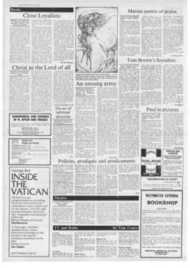Page 3, 2nd July 1982
Page 3

Report an error
Noticed an error on this page?If you've noticed an error in this article please click here to report it.
Tags
Share
Related articles
Marcinkus 'to Resign'
Archbishop Quits Bank
Marcinkus Retires
Marcinkus Name To Feature Large In Trial
Mystery Surrounds Dead Italian Banker
Archbishop Marcinkus and his unhappy choice of friends
ROBERTO CALVI was found hanging dead from Blackfriars Bridge a week ago. Desmond O'Grady traces the link between him and the vexed affairs of the Vatican Bank.
ARCHBISHOP Paul Marcinkus, head of the Vatican Bank, is unfortunate in his choice of friends. First there was Michele Sindona, the Sicilian financier now serving a lengthy prison sentence for bankruptcy in the United States, Then Roberto Calvi, President of the Milanese Ambrosiano Bank, whose dead body was recently found dartgling from a scaffolding under London's Blackfriars Bridge. •
On May 31 the Italian Central Bank, The Banca d'Italia, asked Calvi's bank to account for 1.4 billion in debt and interest charges incurred by four subsidiaries since 1978.
Sindona was not only a crooked banker but, it emerged, a leading Freemason linked to the Mafia.
Calvi seems from the same mould. Marcinkus was friendly with both and his critics within the Vatican say he should be replaced by someone with less compromising acquaintances and more financial nous.
The American Marcinkus, 50, has long been under fire because he heads the institute for the works of religion which operates in the Vatican but handles accounts which are not those of the Vatican — for instance, those of religious orders.
It is commonly called the Vatican Bank but the Vatican says it is simply a bank which operates in Vatican City, A persistent accusation against the institute is that it is used to evade Italian regulations against the export of capital.
A Cardinalate Commission oversees the bank but members say they have very little idea of the bank's operations: at meetings they are presented with a brief report but are not allowed to take It away nor can they elicit much more information.
Marcinkus has a very free hand despite opposition within the Vatican believed to be headed by Cardinal Agostino Casaroli, the Secretary State, who has long wanted more trnasparent financial management.
The fact is that Marcinkus has one extremely valuable supporter: John Paul II. Marcinkus is of Lithuanian descent. This may win JOhn Paul's
sympathy; more certainly, he appreciates the work Marcinkus does in organising his trips and acting as unofficial bodyguard on them.
The Ambrosiano Bank, which has now been placed under a Bank Italy Commissariat, was known as the bank used by the Milan diocese.
It was this reputation which led to the Vatican bank's involvement but in recent years the Ambrosiano had changed from a solid, sober bank to one frantically chasing the dollar.
Marcinkus has just resigned as one of the five directors of one of the Ambrosiano's affiliates: the Banco Ambrosiano Overseas of Nassau in the Bahamas. (Calvi was President).
Earlier this year Marcinkus told
the Italian weekly Panorurnu tIi4t Vatican places its money where it will bring best returns and, from this point of view, Calvi, "who was recommended 10 years ago by the Milan Curia, deserves our trust".
Officially, the Vatican controls only 1.68 per cent of the Ambrosiano but a Bank Italy inspection of the Milanese bank produced these comments: "... the institute for the works of religion is closely linked with the Ambrosiano ... as shown by its constant presence in delicate operations about which we have ample reservations".
Journalists have submitted to Marcinkus a series of questions on the links between the Institute for the Works of Religion and the Ambrosiano, including: did the institute issue letters of guarantee for the Ambrosiano? Did the institute, on 18 June when Marcinkus returned with John Paul II from Geneva, refuse to cover the Ambrosiano's debts? Did Marcinkus divide with Calvi S6 million after the Ambrosiano bought Sindona's firm -Pacchetti"?
It is unlikely the journalists questions will receive a response. Sources close to Marcinkus claim the Vatican did not lose money out of its dealings with the Ambrosiano and when it became clear Calvi was a crook, it refused to bail him out.
This argument has its validity although there have been repeated accusations that Calvi was another Sindona. Did the Vatican simply discount these as scurrilous Press attacks? Last July Calvi was convicted to four years jail and fined 1.2 million (£690,000) for illegally exporting S26.4 million (£15 million).
The question remains: Why should the Vatican have been linked with the two biggest "con men" on the Italian financial scene?
The Vatican rarely transfers anyone publicly criticised to avoid endorsing the charges. But recently Archbishop Marcinkus was made Governor of Vatican City-State, a should lead to a Cardinalta hat in the next Consistory (and, incidentally, will mean he has to handle the "hot potato" of the Vatican employees' trade union). This post does provide a convenient Opportunity to release him from the Institute for the Works of Religion presidency. It remains to be seen if John Paul will take the opportunity. Even if he does, the Vatican Bank seems sure to remain an "Aunt Sally".
blog comments powered by Disqus











